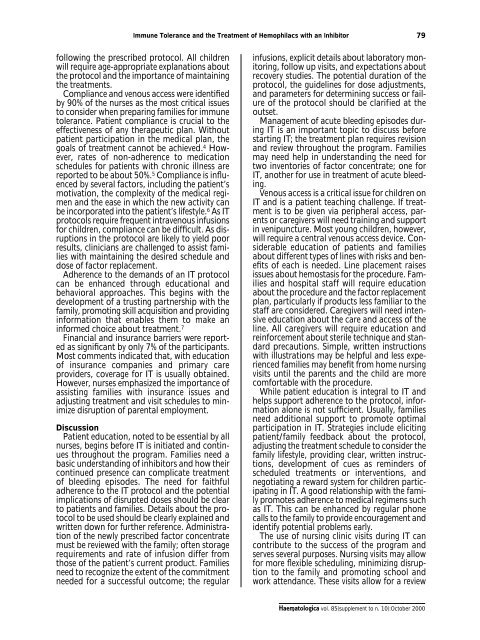Haematologica 2000;85:supplement to no. 10 - Supplements ...
Haematologica 2000;85:supplement to no. 10 - Supplements ...
Haematologica 2000;85:supplement to no. 10 - Supplements ...
You also want an ePaper? Increase the reach of your titles
YUMPU automatically turns print PDFs into web optimized ePapers that Google loves.
Immune Tolerance and the Treatment of Hemophilacs with an Inhibi<strong>to</strong>r 79<br />
following the prescribed pro<strong>to</strong>col. All children<br />
will require age-appropriate explanations about<br />
the pro<strong>to</strong>col and the importance of maintaining<br />
the treatments.<br />
Compliance and ve<strong>no</strong>us access were identified<br />
by 90% of the nurses as the most critical issues<br />
<strong>to</strong> consider when preparing families for immune<br />
<strong>to</strong>lerance. Patient compliance is crucial <strong>to</strong> the<br />
effectiveness of any therapeutic plan. Without<br />
patient participation in the medical plan, the<br />
goals of treatment can<strong>no</strong>t be achieved. 4 However,<br />
rates of <strong>no</strong>n-adherence <strong>to</strong> medication<br />
schedules for patients with chronic illness are<br />
reported <strong>to</strong> be about 50%. 5 Compliance is influenced<br />
by several fac<strong>to</strong>rs, including the patient’s<br />
motivation, the complexity of the medical regimen<br />
and the ease in which the new activity can<br />
be incorporated in<strong>to</strong> the patient’s lifestyle. 6 As IT<br />
pro<strong>to</strong>cols require frequent intrave<strong>no</strong>us infusions<br />
for children, compliance can be difficult. As disruptions<br />
in the pro<strong>to</strong>col are likely <strong>to</strong> yield poor<br />
results, clinicians are challenged <strong>to</strong> assist families<br />
with maintaining the desired schedule and<br />
dose of fac<strong>to</strong>r replacement.<br />
Adherence <strong>to</strong> the demands of an IT pro<strong>to</strong>col<br />
can be enhanced through educational and<br />
behavioral approaches. This begins with the<br />
development of a trusting partnership with the<br />
family, promoting skill acquisition and providing<br />
information that enables them <strong>to</strong> make an<br />
informed choice about treatment. 7<br />
Financial and insurance barriers were reported<br />
as significant by only 7% of the participants.<br />
Most comments indicated that, with education<br />
of insurance companies and primary care<br />
providers, coverage for IT is usually obtained.<br />
However, nurses emphasized the importance of<br />
assisting families with insurance issues and<br />
adjusting treatment and visit schedules <strong>to</strong> minimize<br />
disruption of parental employment.<br />
Discussion<br />
Patient education, <strong>no</strong>ted <strong>to</strong> be essential by all<br />
nurses, begins before IT is initiated and continues<br />
throughout the program. Families need a<br />
basic understanding of inhibi<strong>to</strong>rs and how their<br />
continued presence can complicate treatment<br />
of bleeding episodes. The need for faithful<br />
adherence <strong>to</strong> the IT pro<strong>to</strong>col and the potential<br />
implications of disrupted doses should be clear<br />
<strong>to</strong> patients and families. Details about the pro<strong>to</strong>col<br />
<strong>to</strong> be used should be clearly explained and<br />
written down for further reference. Administration<br />
of the newly prescribed fac<strong>to</strong>r concentrate<br />
must be reviewed with the family; often s<strong>to</strong>rage<br />
requirements and rate of infusion differ from<br />
those of the patient’s current product. Families<br />
need <strong>to</strong> recognize the extent of the commitment<br />
needed for a successful outcome; the regular<br />
infusions, explicit details about labora<strong>to</strong>ry moni<strong>to</strong>ring,<br />
follow up visits, and expectations about<br />
recovery studies. The potential duration of the<br />
pro<strong>to</strong>col, the guidelines for dose adjustments,<br />
and parameters for determining success or failure<br />
of the pro<strong>to</strong>col should be clarified at the<br />
outset.<br />
Management of acute bleeding episodes during<br />
IT is an important <strong>to</strong>pic <strong>to</strong> discuss before<br />
starting IT; the treatment plan requires revision<br />
and review throughout the program. Families<br />
may need help in understanding the need for<br />
two inven<strong>to</strong>ries of fac<strong>to</strong>r concentrate; one for<br />
IT, a<strong>no</strong>ther for use in treatment of acute bleeding.<br />
Ve<strong>no</strong>us access is a critical issue for children on<br />
IT and is a patient teaching challenge. If treatment<br />
is <strong>to</strong> be given via peripheral access, parents<br />
or caregivers will need training and support<br />
in venipuncture. Most young children, however,<br />
will require a central ve<strong>no</strong>us access device. Considerable<br />
education of patients and families<br />
about different types of lines with risks and benefits<br />
of each is needed. Line placement raises<br />
issues about hemostasis for the procedure. Families<br />
and hospital staff will require education<br />
about the procedure and the fac<strong>to</strong>r replacement<br />
plan, particularly if products less familiar <strong>to</strong> the<br />
staff are considered. Caregivers will need intensive<br />
education about the care and access of the<br />
line. All caregivers will require education and<br />
reinforcement about sterile technique and standard<br />
precautions. Simple, written instructions<br />
with illustrations may be helpful and less experienced<br />
families may benefit from home nursing<br />
visits until the parents and the child are more<br />
comfortable with the procedure.<br />
While patient education is integral <strong>to</strong> IT and<br />
helps support adherence <strong>to</strong> the pro<strong>to</strong>col, information<br />
alone is <strong>no</strong>t sufficient. Usually, families<br />
need additional support <strong>to</strong> promote optimal<br />
participation in IT. Strategies include eliciting<br />
patient/family feedback about the pro<strong>to</strong>col,<br />
adjusting the treatment schedule <strong>to</strong> consider the<br />
family lifestyle, providing clear, written instructions,<br />
development of cues as reminders of<br />
scheduled treatments or interventions, and<br />
negotiating a reward system for children participating<br />
in IT. A good relationship with the family<br />
promotes adherence <strong>to</strong> medical regimens such<br />
as IT. This can be enhanced by regular phone<br />
calls <strong>to</strong> the family <strong>to</strong> provide encouragement and<br />
identify potential problems early.<br />
The use of nursing clinic visits during IT can<br />
contribute <strong>to</strong> the success of the program and<br />
serves several purposes. Nursing visits may allow<br />
for more flexible scheduling, minimizing disruption<br />
<strong>to</strong> the family and promoting school and<br />
work attendance. These visits allow for a review<br />
<strong>Haema<strong>to</strong>logica</strong> vol. <strong>85</strong>(<strong>supplement</strong> <strong>to</strong> n. <strong>10</strong>):Oc<strong>to</strong>ber <strong>2000</strong>
















